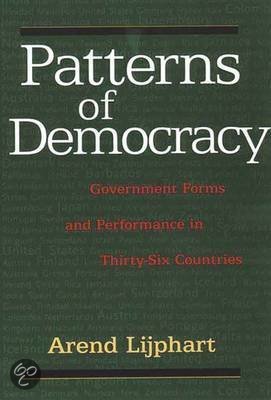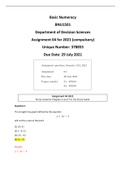Chapter 1
In Practice governments exhibit a variety of formal governmental institutions, like legislatures and courts, as
well as Political party and interest Group systems. There are clear patterns and regularities that appear when
these institutions are examined from the perspective of how majoritarian or how consensual their rules and
practices are.
There is this majoritarian-consensus contrats:
• This derives from the basic and literal definition of democracy, i.e. Government by the people
• Representative democracy, government by the representatives of the people
• Governments are in line with people’s preferences
Who will do the governing and to whose interests should the government be responsive when the people are in
disagreement and have divergent preferences?
Majoritarian model Consensus model
Government by the majority. This model is in line Majority as a minimum requirement instead of being
with the majority’s wishes. Obviously this comes satisfied with narrow decision-making majorities. It
closer to the democracy ideal of government: by and seeks to maximize the size of these majorities. Its rules
for the people than government by and responsive and institutions aim at broad participation in
to a majority government and broad agreement on he policies that
the government should pursue. It is about dispersion
and limiting power.
Focus on exclusive, competitive and adversarial. Focus on inclusiveness, bargaining and compromise =
negotiation democracy
Ten differences with regard to the most important democratic institutions and rules can be deduces from the
majoritarian and consensus principles.
• They are closely related
• The variables cluser in two seperate dimenions:
• The first dimensions groups five characteristics of the arrangement of executive power, the party and electoral
systems and the interest groups = executives-parties dimension.
• The second dimension is associated with the contrast between federalism and unitaru government = federal-
unitary dimension.
Variables of the first dimension
1. Concentration of executive power in single-party majority cabinets vs. executive power-sharing in the broad
multi-party coalitions.
2. Executive-legislative relations in which the executive is dominant vs. Executive-legislative balance of
power.
3. Two-party systems vs. Multi-party systems
4. Majoritarian and disproportional election systems vs. Proportional representation (PR)
5. Pluralist interest Group systems with free-for-all competition among groups vs. Coordinated and corporatist
interest group systems aimed at compromise and concertation.
Variables of the second dimension
1. Unitary and centralised government vs. Federal and decentralised government
2. Concentration of legislative power in an unicameral legislature vs. Division of legislative power between
two equally strong but differently constituted houses.
3. Flexible Constitution that can be amended by simple majorities vs. Rigid constitutions that can only be
changed by extraordinary majorities.
4. Systems in which legislatives have the final word on the constitutionality of their own legislative vs.
Systems in which laws are subject to judicial review of their constitutional or Supreme courts.
5. Central Banks that are dependent on the executive vs. Independent Central banks.
Definition of federalism
• Guaranteed division of power between the Central govenment and regional governments
• Secondary characteristics:
1
,• Bicameralism
• Rigid constitution
• Strong judicial review
The guarantee of a Federal division of power can only work well if:
• Both the guarantee and the exact lines of the division of power are clearly stated in the Constitution and this
guarantee cannot be changed unilaterally at either the Central or regional level.
• This implies the need for a rigid Constitution
• There is a neutral arbiter who can resolve conflicts concerning the division of power between the two levels
of government.
• Need for judicial review.
• There is a Federal chamber in which the national legislature in which the regions have strong representation.
• This implies the need for strong bicameralism.
• Protect and promote a decentralised system of government.
Problem(s):
• Why should this dimension be distinct from the other dimension? Why are there two dimensions?
• Why is the Central bank Independence part of the federal-unitary dimension?
A more persuasive explanation of the two-dimensional pattern is the distinction between collective Agency and
shared responsibility and divided agencies and responsibilities.
Chapter 2 - The Westminster model of Democracy
- UK is the best known example of a majoritarian model.
Prototypes
• The United Kingdom
• New Zealand
• Barbados (only with regard to the first dimension)
The Westminster model, UK
- The concentration of executive power in one-party and bare-majority cabinets.
- Cabinet is the most Powerful organs.
- Cabinets are composed of the party that has the majority of Seats in the House of Commons.
- Minorities are not included.
- Coalition cabinets are rare.
- There is a two-party system in which two principal parties are of equal strength.
o The party that wins represents a narrow majority and the Minority is relatively large.T he
British one-party and bare-majority cabinet is the embodiment of the Principle of majority. A
large Minority is excluded from power and condemned to the role of opposition.
- Cabinet dominance
- There is a parliamentary system of government. This means that cabinets are dependent on the
confidence of parliament.
o In theory, the house of Commons can vote a cabinet out of office. In other words, the house of
Commons controls the cabinet.
o In reality, the relationship is reversed.
- Because cabinet is composed of the leaders of a cohesive majority party in the house of Commons, it is
normally backed by the majority in the house of Commons.
o They can confidently count on staying in office and getting its legislative proposals approved.
Strong cabinet leadership depends on majority support in the house of Commons and the
cohesiveness of the majority party. A cabinet loses aome of its predominant position when
either or both these conditions are absent.
o The 1970s are the only exception in the history of the UK in which there was a Minority
government.
- Unwritten rule: only an explicit vote of no confidence necessitates resignation or new elections.
- It is the disciplined two-party system rather than the parliamentary system that gives rise to executive
dominance.
- Two-party system
o Two large parties in the UK:
2
, The Conservative Party
The Labour Party
Together they almost always gain 80% of the votes (at least)
o Minor parties:
Liberals
Social Democratic Party
They are not large enough to be the overall victors.
- Majoritarian and disproportional system of election
o The House of Commons is a large legislative body with a membership that has varied between
625 and 659 members since 1945. Members are selected in single-member districts according
to the plurality method, i.e. first-past-the-post:
The candidate with the majority vote, or, if there is no majority with the largest
minorities vote wins.
This produces highly disproportional results.
Example of 2005:
Labour party wins 35.2% of the votes but obtained 355 out of 646 Seats in parliament. Rae calls this a
manufactured majority, i.e. majorities which are artificially created by the electoral system out of Mere plurality
vote.
Chapter 4 - Thirty-six Democracies
- Systematic comparison of the 36 countries that were democratic in the middle of 2010 and that had
been continuously democratic since 1989 or earlier.
- Analysis 1945-2010
- Criteria for selecting these countries will be explained and for choosing the minimum Number of years
of democratic experience.
Definitions of Democracy
Democracy defined by Robert A. Dahl (1971) by means of 8 criteria:
- The right to vote
- The right to be elected
- The right of political leaders to compete for support and votes
- Elections that are free and fair
- Freedom of association
- Freedom of expression
- Alternative sources of information
- Institutions for making public policies depend on votes and other expressions of preference
Lincoln’s definition: Government by the people (or by representatives of the people) and for the people.
- By the people implies universal suffrage, eligibility for public office, and free and fair elections
o Elections cannot be free and fair unless here is freedom of expression and Association both
before and between elections.
- For the people implies responsiveness by the government to the voters’ preferences.
There are 36 countries which can be regarded democratic in 2010 and as having been democratic for
more than 20 years. Therefore, these countries are analysed in this book.
Freedom House
- Countries are rated as free, partly free or not free
- These findings are based on two sets of criteria:
o Political Rights - Rights to particpate in free and competitive elections
o Civil liberties - Freedom of speech and Association
Four borderline cases are also included:
- India = the least developed + ethnically divided
- Argentina
- Trinidad = ethnically divided
- Tobago
3
, There are two reasons for the requirement that countries be not just democratic but democratic for an extended
period:
- It provides assurance that the democracies studied are not emphermeral entities but reasonably stable
and consolidated systems.
In order to study results that elections tend to have, the kinds of cabinets that tend to be formed, and the
durability of these cabinets in a particular country, we need to be able to measure more than just one or
a few of these elections and cabinets.
The requirement of a minimum time span of more than twenty years of democratic experience necessarily means
that quite a few democracies had to be omitted from the analysis. If the time span had only been 10 years, 25
more countries could have been included in the analysis.
Thirty-Six Diverse Democracies
The set of thirty-six democracies includes representatives of each of the three waves of democratization
identified by Samuel P. Huntington. Using a rather lenient definitized of “universal” suffrage - the right to vote
for at least 50 percent of adult males –
- Huntington sees a long first wave starting as early as 1828 and lasting until 1926.
- A short second wave from 1943 to 1962
- A third wave starting in 1974
- Two reverse waves, in which Democracy collapsed in many countries, occurred between the three
waves of democratization.
Several countries that experienced reverse waves participated in more than one forward wave. E.g.
Argentina, Greece and Uruguay were involved in all three forward waves and in both reverse waves.
All of the countries listed in table 4.1 as having
been continuously democratic since the late
1940s, except Israel, were already part of the
first Huntington’s waves. About half were also
in the second wave: those in which democracy
failed in the first reverse wave, like Germany
and Italy, and countries where Democracy was
interrupted by German occupation furring
WWII. The countries listed as having been
democratic since the 1950s and 1960s belong to
the second wave; for the 1960s group,
democratization came about as a result of
decolonization. Huntington Uses 1962 as the
year in which the second wave ended, but
Botswana, Barbados, Malta and even the
Bahamas (not independent until 1973) should
be included in the second w ave. The end of the
Portuguese dictatorship in 1974 initiated the
third wave, which also encompasses the other
democracies in the 1970s and 1980s groups
(except the Bahamas) and which continued in
the 1990s, especially in Eastern Europe, Latin
America and Africa. The Twenty
democracies that have been continuously
democratic since the 1940s (or earlier) are a Rather homogenous group in several key respects, except their
degree of pluralism: they are all economically developed, industrialized, and urbanized; with the exception of
Japan, they belong to the Western Judeo-Christian world; and most are geographically concentrated in the North
Atlantic area. However, the addition of the second wave and third-wave democracies adds a Great deal of
diversity. Three major differences are highlighted:
- The degree to which the thirty-six democracies are plural societies; degree of societal division. This
variable is commonly operationalized as the number and relative sizes of the ethnic groups in different
countries. This enhances the element societal division. For instance, all other things being equal, a
country consisting of three ethnic groups of equal size is less divided than one with four such equal
groups, and a country with two ethnic groups comprising 90 and 10 percent of the population is less
divided than one with two groups of 50 percent each.
o However, there are also disadvantages in doing so:
4
In Practice governments exhibit a variety of formal governmental institutions, like legislatures and courts, as
well as Political party and interest Group systems. There are clear patterns and regularities that appear when
these institutions are examined from the perspective of how majoritarian or how consensual their rules and
practices are.
There is this majoritarian-consensus contrats:
• This derives from the basic and literal definition of democracy, i.e. Government by the people
• Representative democracy, government by the representatives of the people
• Governments are in line with people’s preferences
Who will do the governing and to whose interests should the government be responsive when the people are in
disagreement and have divergent preferences?
Majoritarian model Consensus model
Government by the majority. This model is in line Majority as a minimum requirement instead of being
with the majority’s wishes. Obviously this comes satisfied with narrow decision-making majorities. It
closer to the democracy ideal of government: by and seeks to maximize the size of these majorities. Its rules
for the people than government by and responsive and institutions aim at broad participation in
to a majority government and broad agreement on he policies that
the government should pursue. It is about dispersion
and limiting power.
Focus on exclusive, competitive and adversarial. Focus on inclusiveness, bargaining and compromise =
negotiation democracy
Ten differences with regard to the most important democratic institutions and rules can be deduces from the
majoritarian and consensus principles.
• They are closely related
• The variables cluser in two seperate dimenions:
• The first dimensions groups five characteristics of the arrangement of executive power, the party and electoral
systems and the interest groups = executives-parties dimension.
• The second dimension is associated with the contrast between federalism and unitaru government = federal-
unitary dimension.
Variables of the first dimension
1. Concentration of executive power in single-party majority cabinets vs. executive power-sharing in the broad
multi-party coalitions.
2. Executive-legislative relations in which the executive is dominant vs. Executive-legislative balance of
power.
3. Two-party systems vs. Multi-party systems
4. Majoritarian and disproportional election systems vs. Proportional representation (PR)
5. Pluralist interest Group systems with free-for-all competition among groups vs. Coordinated and corporatist
interest group systems aimed at compromise and concertation.
Variables of the second dimension
1. Unitary and centralised government vs. Federal and decentralised government
2. Concentration of legislative power in an unicameral legislature vs. Division of legislative power between
two equally strong but differently constituted houses.
3. Flexible Constitution that can be amended by simple majorities vs. Rigid constitutions that can only be
changed by extraordinary majorities.
4. Systems in which legislatives have the final word on the constitutionality of their own legislative vs.
Systems in which laws are subject to judicial review of their constitutional or Supreme courts.
5. Central Banks that are dependent on the executive vs. Independent Central banks.
Definition of federalism
• Guaranteed division of power between the Central govenment and regional governments
• Secondary characteristics:
1
,• Bicameralism
• Rigid constitution
• Strong judicial review
The guarantee of a Federal division of power can only work well if:
• Both the guarantee and the exact lines of the division of power are clearly stated in the Constitution and this
guarantee cannot be changed unilaterally at either the Central or regional level.
• This implies the need for a rigid Constitution
• There is a neutral arbiter who can resolve conflicts concerning the division of power between the two levels
of government.
• Need for judicial review.
• There is a Federal chamber in which the national legislature in which the regions have strong representation.
• This implies the need for strong bicameralism.
• Protect and promote a decentralised system of government.
Problem(s):
• Why should this dimension be distinct from the other dimension? Why are there two dimensions?
• Why is the Central bank Independence part of the federal-unitary dimension?
A more persuasive explanation of the two-dimensional pattern is the distinction between collective Agency and
shared responsibility and divided agencies and responsibilities.
Chapter 2 - The Westminster model of Democracy
- UK is the best known example of a majoritarian model.
Prototypes
• The United Kingdom
• New Zealand
• Barbados (only with regard to the first dimension)
The Westminster model, UK
- The concentration of executive power in one-party and bare-majority cabinets.
- Cabinet is the most Powerful organs.
- Cabinets are composed of the party that has the majority of Seats in the House of Commons.
- Minorities are not included.
- Coalition cabinets are rare.
- There is a two-party system in which two principal parties are of equal strength.
o The party that wins represents a narrow majority and the Minority is relatively large.T he
British one-party and bare-majority cabinet is the embodiment of the Principle of majority. A
large Minority is excluded from power and condemned to the role of opposition.
- Cabinet dominance
- There is a parliamentary system of government. This means that cabinets are dependent on the
confidence of parliament.
o In theory, the house of Commons can vote a cabinet out of office. In other words, the house of
Commons controls the cabinet.
o In reality, the relationship is reversed.
- Because cabinet is composed of the leaders of a cohesive majority party in the house of Commons, it is
normally backed by the majority in the house of Commons.
o They can confidently count on staying in office and getting its legislative proposals approved.
Strong cabinet leadership depends on majority support in the house of Commons and the
cohesiveness of the majority party. A cabinet loses aome of its predominant position when
either or both these conditions are absent.
o The 1970s are the only exception in the history of the UK in which there was a Minority
government.
- Unwritten rule: only an explicit vote of no confidence necessitates resignation or new elections.
- It is the disciplined two-party system rather than the parliamentary system that gives rise to executive
dominance.
- Two-party system
o Two large parties in the UK:
2
, The Conservative Party
The Labour Party
Together they almost always gain 80% of the votes (at least)
o Minor parties:
Liberals
Social Democratic Party
They are not large enough to be the overall victors.
- Majoritarian and disproportional system of election
o The House of Commons is a large legislative body with a membership that has varied between
625 and 659 members since 1945. Members are selected in single-member districts according
to the plurality method, i.e. first-past-the-post:
The candidate with the majority vote, or, if there is no majority with the largest
minorities vote wins.
This produces highly disproportional results.
Example of 2005:
Labour party wins 35.2% of the votes but obtained 355 out of 646 Seats in parliament. Rae calls this a
manufactured majority, i.e. majorities which are artificially created by the electoral system out of Mere plurality
vote.
Chapter 4 - Thirty-six Democracies
- Systematic comparison of the 36 countries that were democratic in the middle of 2010 and that had
been continuously democratic since 1989 or earlier.
- Analysis 1945-2010
- Criteria for selecting these countries will be explained and for choosing the minimum Number of years
of democratic experience.
Definitions of Democracy
Democracy defined by Robert A. Dahl (1971) by means of 8 criteria:
- The right to vote
- The right to be elected
- The right of political leaders to compete for support and votes
- Elections that are free and fair
- Freedom of association
- Freedom of expression
- Alternative sources of information
- Institutions for making public policies depend on votes and other expressions of preference
Lincoln’s definition: Government by the people (or by representatives of the people) and for the people.
- By the people implies universal suffrage, eligibility for public office, and free and fair elections
o Elections cannot be free and fair unless here is freedom of expression and Association both
before and between elections.
- For the people implies responsiveness by the government to the voters’ preferences.
There are 36 countries which can be regarded democratic in 2010 and as having been democratic for
more than 20 years. Therefore, these countries are analysed in this book.
Freedom House
- Countries are rated as free, partly free or not free
- These findings are based on two sets of criteria:
o Political Rights - Rights to particpate in free and competitive elections
o Civil liberties - Freedom of speech and Association
Four borderline cases are also included:
- India = the least developed + ethnically divided
- Argentina
- Trinidad = ethnically divided
- Tobago
3
, There are two reasons for the requirement that countries be not just democratic but democratic for an extended
period:
- It provides assurance that the democracies studied are not emphermeral entities but reasonably stable
and consolidated systems.
In order to study results that elections tend to have, the kinds of cabinets that tend to be formed, and the
durability of these cabinets in a particular country, we need to be able to measure more than just one or
a few of these elections and cabinets.
The requirement of a minimum time span of more than twenty years of democratic experience necessarily means
that quite a few democracies had to be omitted from the analysis. If the time span had only been 10 years, 25
more countries could have been included in the analysis.
Thirty-Six Diverse Democracies
The set of thirty-six democracies includes representatives of each of the three waves of democratization
identified by Samuel P. Huntington. Using a rather lenient definitized of “universal” suffrage - the right to vote
for at least 50 percent of adult males –
- Huntington sees a long first wave starting as early as 1828 and lasting until 1926.
- A short second wave from 1943 to 1962
- A third wave starting in 1974
- Two reverse waves, in which Democracy collapsed in many countries, occurred between the three
waves of democratization.
Several countries that experienced reverse waves participated in more than one forward wave. E.g.
Argentina, Greece and Uruguay were involved in all three forward waves and in both reverse waves.
All of the countries listed in table 4.1 as having
been continuously democratic since the late
1940s, except Israel, were already part of the
first Huntington’s waves. About half were also
in the second wave: those in which democracy
failed in the first reverse wave, like Germany
and Italy, and countries where Democracy was
interrupted by German occupation furring
WWII. The countries listed as having been
democratic since the 1950s and 1960s belong to
the second wave; for the 1960s group,
democratization came about as a result of
decolonization. Huntington Uses 1962 as the
year in which the second wave ended, but
Botswana, Barbados, Malta and even the
Bahamas (not independent until 1973) should
be included in the second w ave. The end of the
Portuguese dictatorship in 1974 initiated the
third wave, which also encompasses the other
democracies in the 1970s and 1980s groups
(except the Bahamas) and which continued in
the 1990s, especially in Eastern Europe, Latin
America and Africa. The Twenty
democracies that have been continuously
democratic since the 1940s (or earlier) are a Rather homogenous group in several key respects, except their
degree of pluralism: they are all economically developed, industrialized, and urbanized; with the exception of
Japan, they belong to the Western Judeo-Christian world; and most are geographically concentrated in the North
Atlantic area. However, the addition of the second wave and third-wave democracies adds a Great deal of
diversity. Three major differences are highlighted:
- The degree to which the thirty-six democracies are plural societies; degree of societal division. This
variable is commonly operationalized as the number and relative sizes of the ethnic groups in different
countries. This enhances the element societal division. For instance, all other things being equal, a
country consisting of three ethnic groups of equal size is less divided than one with four such equal
groups, and a country with two ethnic groups comprising 90 and 10 percent of the population is less
divided than one with two groups of 50 percent each.
o However, there are also disadvantages in doing so:
4











